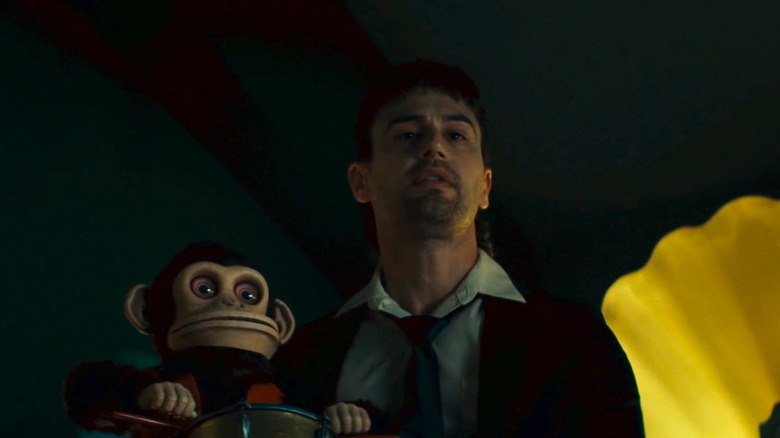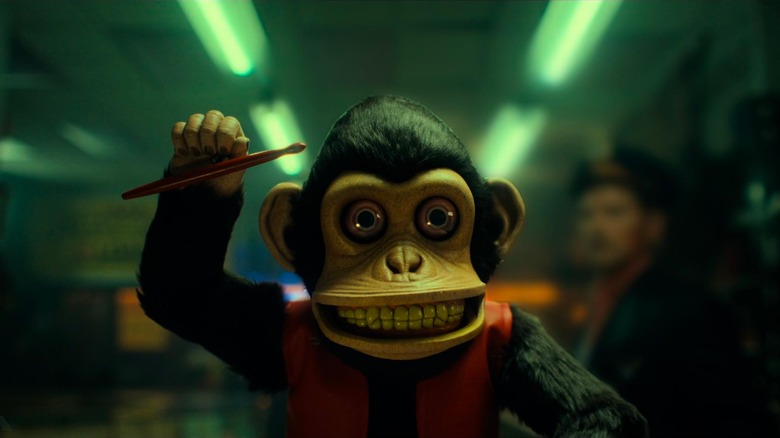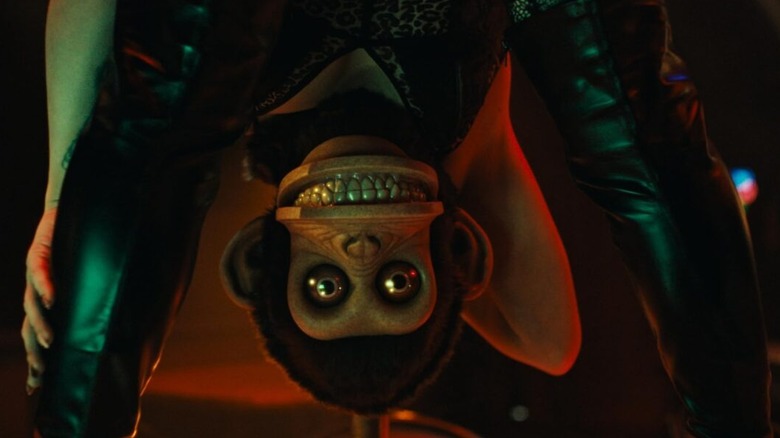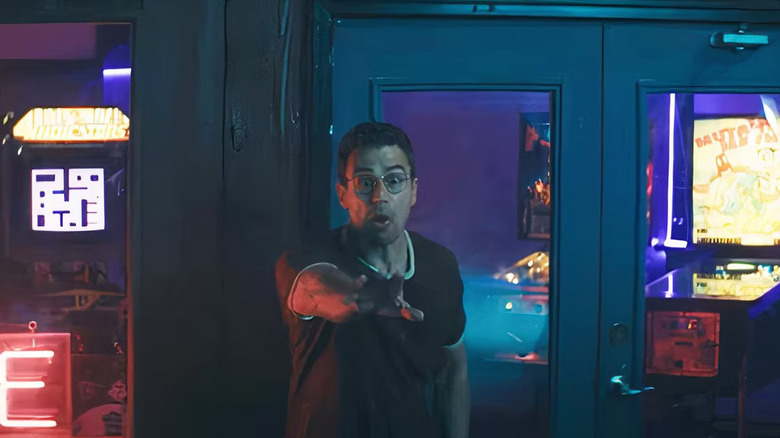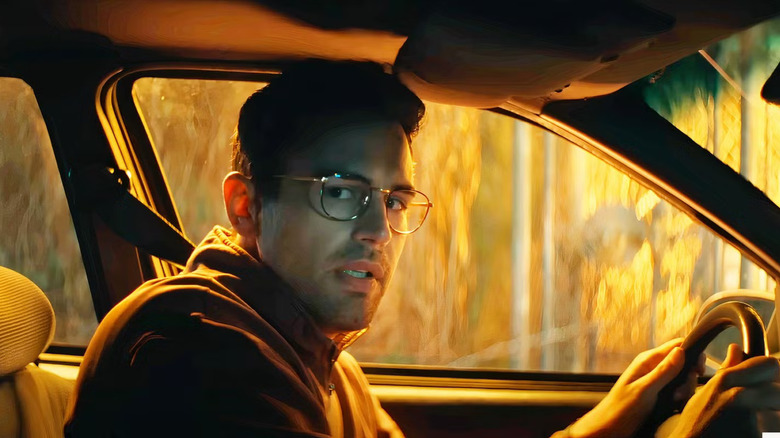5 Biggest Differences Between The Two Versions Of Stephen King's The Monkey
Osgood Perkins' 2025 film "The Monkey" was based on a 1980 short story by Stephen King, but drastically alters the original story's tone. King's rendition was a straightforward horror story about a haunted wind-up monkey toy that, when activated to smash its cymbals together, mysterious summons misfortune. The main character of the story, Hal, figured out the machinations of the monkey as a child, and was perturbed to rediscover the monkey as an adult. The story ends when Hal tosses the toy into a lake. All the fish in the lake die.
Perkins' movie is a little more complex, and a lot funnier. /Film's own Chris Evangelista detailed the many differences between the story and Perkins' film, including a few that might come as a surprise. It seems that Disney owns the copyright to the original 1932 model of the Louis Marx & Co. Cymbal Monkey Toy, so Perkins was forced to turn the monkey into one that beats a drum. Disney bought the rights when they distributed "Toy Story."
Perkins' film was a high-profile release ... but it wasn't the first. It seems that a New York filmmaker named Spencer Sherry made an hour-long feature adaptation of King's "The Monkey" back in 2023 as part of the famed author's Dollar Baby program. The Dollar Baby program, for those unfamiliar, is a decades-old practice wherein King licenses his short stories to aspiring film students for only one dollar. He knows a lot of film students would like to adapt his work, and he wants to encourage them. Spencer Sherry licensed "The Monkey" and made a film that played mostly in local theaters around Saratoga Springs.
The 2023 film and the 2025 film are very different indeed, including the below notable differences.
Spencer Sherry's The Monkey (2023) is a sequel
Spencer Sherry's version of "The Monkey" is, in essence, two stories in one. In flashbacks, it details the events of King's short story, wherein Hal (Vaden Thurgood) has already discovered the curse of a cymbal playing monkey toy that seems to invite misfortune. In the short's opening scenes, Hal's hand is caught between the money's cymbals, leaving a round scar on either side of his hand. Hal's young son Pete (Jarem Molinski) is almost struck by a car. Luckily, the boy's life in spared.
These events intercut with the present day wherein Pete (Mark Koenig), now an adult, is expecting a child with his wife Melissa (Lily Moran). Hal, now played by John Romeo, is on his deathbed, having spent his life being a terrible father to his two sons. Pete's brother, Terry (Casey Dunn), is still bitter over their bad childhood, and resents that Pete is still seeing his father. The bulk of Sherry's movie is about how Pete has to deal with the bleak legacy of the monkey after it reappears in his life. He recalls his father dispensing of it when he was a child, a scene taken straight from King's story.
Perkin's movie is also intergenerational, but only briefly involves Hal's father (Adam Scott) trying to sell the monkey to a pawn shop. Perkins' film spends a portion of the movie in Hal's childhood, and then fast-forwards to his adulthood where he (now played by Theo James) concerns himself with the dark legacy that the monkey may pass to his own teenage son, Pete (Colin O'Brien). It's curious that both Sherry and Perkins elected to make "The Monkey" into stories of bad dads and intergenerational evil.
Osgood Perkins' The Monkey (2025) is a comedy
The biggest difference between the two "Monkeys" is a matter of tone. Spencer Sherry made a downbeat, personal film that is more interpersonal drama than horror film. It has its share of scares — there's a dream sequence in the middle involving a pregnant woman with a zipper on her stomach — but most of the film is about Pete and/or Hal interacting with their family members and freaking out over the influence the Monkey has on their lives. King's story was a horror story, and Sherry attempted to remain true to that spirit. The film is about trying to retain normalcy while standing under a vague cloud of familiar chaos.
Perkins, meanwhile, made more or less a comedy film. People don't just die in Perkins' "The Monkey," they die spectacularly. When a woman jumps into an electrified pool, she isn't just cooked alive, but exploded into several splattery pieces. Her leg lands next to Hal, who is talking on the telephone.
And it's gleefully nasty about it. Another major change Perkins made was to tell a story of twin brothers, rather than just Hal. The new character, Bill (also played by Theo James), is cruel to his brother, and seems to actively hate him. Bill bullies Hal incessantly, and it will be he who ends up wanting to take control of the Monkey. The message of Perkins' "The Monkey" seems to be that life is so random and cruel that it's downright hilarious. Sherry's "The Monkey" seems to face in the direction of freedom, while Perkins' is downright nihilistic
Spencer Sherry's The Monkey is part of a Stephen King connected universe
Several scenes in Spencer Sherry's "The Monkey" take place in a hospital where the elderly Hal is bedridden and where Pete's wife will soon give birth. There is an amusing aside in Spencer Sherry's "The Monkey" wherein a pair of hospital workers, not main characters, have a conversation about how to deal with troublesome visitors. They are beset, you see, by a panicked young businessman in an oversized suit. He wails about how he needs to see a doctor immediately, as his weight loss has been unusually rapid. He yells that he's down to 110 pounds. When the two hospital clerks try to calm him down, he storms out, not the least bit calm.
Stephen King fans will recognize this character as Billy Halleck, the protagonist of the 1984 novel "Thinner." "Thinner" was published under King's pen name Richard Bachman, and follows a selfish, overweight lawyer after he accidentally runs over a Romani woman in his car. Billy uses his lawyerly skills to get himself off the hook legally, but he is punished by the woman's family by being placed under a curse. After a Romani man touches him, saying "thinner," he begins to lose weight no matter how much he eats. It will only be a matter of time before he wastes away entirely.
"Thinner" was adapted into a feature film in 1996, and it starred Robert John Burke as Billy Halleck. That film wasn't very good, but the premise was still intriguing. Spencer Sherry licensed "The Monkey" for adaptation, and was able to cleverly throw in a reference to another Stephen King story as well. Should Sherry want to make a follow-up to "The Monkey," his "Thinner" reference would be a great way in.
Osgood Perkins' The Monkey has clear-cut rules
In Spencer Sherry's "The Monkey," the titular monkey seems to summon misfortune, but it's more a symbol for a legacy of familial angst. It's not very salacious, and the film doesn't revel in death scenes. Perkins' film is just the opposite. Not only is it a comedy film, as mentioned, but it's a supernatural thriller with its own rules. When someone winds up the monkey, it drums for a few moments — music also emanates from within — and someone dies shortly thereafter. The deaths are "Final Destination"-style deaths, in that they are elaborate and gory accidents.
Hal and Bill learn early on, though, that the monkey doesn't take requests. One cannot wind up the monkey and ask it to kill a specific person. It will kill whoever it chooses to kill. The only stipulation seems to be that the monkey will kill someone physically or emotionally close to the winder. The monkey will also never kill the winder themselves. All of these rules are laid out very gradually over the course of Perkins' film. And, of course, if a supernatural widget has rules, then there's going to be a way to manipulate or cancel them to the protagonist's benefit ... or misfortune.
Sherry was attempting to make a mood piece. Perkins was making a more structured thriller. Spencer has stories about panicked fathers finding the monkey in an attic. Perkins is about watching people get stung by bees ... from the inside out.
Both films have unhappy endings
Without spoiling either film, I can say that both versions of "The Monkey" have unhappy endings. Sherry's film, however, offers a tragic twist ending after it looks like everything is going to turn out alright, while Perkins' movie offers a bleak and sardonic twist that a viewer might have seen coming.
In brief, Sherry's "The Monkey" seemingly ends where King's story ends, with Hal escaping the influence of the monkey after drowning it in a lake. Sherry, however, tacks on an epilogue wherein the adult Pete learns what happened to the monkey ... and how that might keep its evil legacy going. Sherry uses the clashing of the monkey's cymbals in a chilling fashion. Sherry also notes that Hal's fate, even if he might have thought himself free of the monkey, might also be bleak. These were gut-punched at the end of a movie that was seemingly going to turn out well for everyone. Rebirth is a recurring motif throughout Sherry's film.
Perkins' film is bleak, but the entire movie was leading up to its semi-surreal ending. As mentioned, Perkins' film has rules, and audiences get to see how far the influence of the monkey can reach within those rules. It seems that the monkey has powers bordering on the apocalyptic.
In both cases, the audience never learn where the monkey came from, why it's cursed, or how it came to play by the rules it plays by. And in both cases, though, the monkey is symbolic, an image of failed paternity and familial neglect.
Sadly, Sherry's film is not currently available online. Visit the 518 Film Network, though, and you may catch wind of any upcoming screenings.
